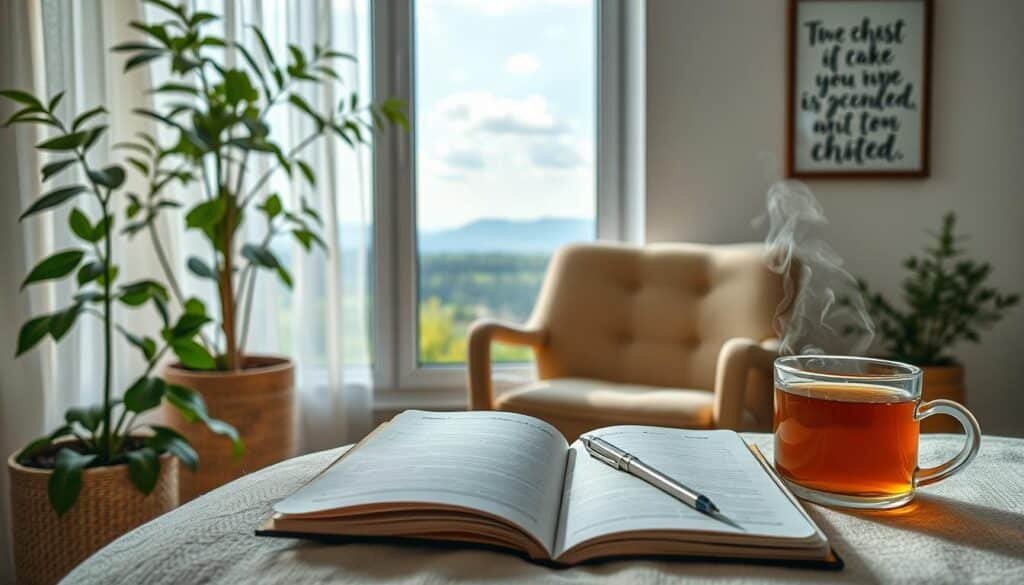Did you know that cognitive-behavioral therapy (CBT) and mindfulness can greatly lessen anxiety1? The National Institute for Health and Care Excellence (NICE) says CBT treatments are top choices for anxiety disorder (GAD) because they work well2. I’m thrilled to share an effective self-help course focused on beating anxiety with practical, proven methods.
This course dives deep into the thoughts, feelings, actions, and body sensations tied to anxiety. With CBT and mindfulness, you’ll learn to handle bad thoughts, deal with panic attacks, and use calming techniques like deep breathing, grounding, and meditations1. Cognitive restructuring is also key, helping you change negative thoughts into positive, realistic ones1.
Joining this program, you’ll gain the skills to worry less, control panic, and build a positive mindset. Plus, groups like Anxiety UK, Mind, and Rethink Mental Illness offer extra help and support along the way2.
Key Takeaways
- CBT and mindfulness strategies are crucial for managing anxiety.
- Breathing exercises, grounding techniques, and guided meditations are included to calm anxiety.
- Negative thoughts are countered with more balanced alternatives through cognitive restructuring.
- Support from organizations like Anxiety UK and Mind can aid in the journey.
- Over planning can exacerbate anxiety and should be managed effectively.
Understanding Anxiety: Causes and Symptoms
To understand anxiety, we look into what causes it and how it shows up. Both physical and emotional signs point out our stress levels. Knowing what sets off our anxiety helps us handle stress and push past fear.
Common Anxiety Triggers
Many things can start anxiety, like bad thoughts, tough times as a kid, or problems with friends3. Bad experiences such as being mistreated also play a big role4. Sometimes, people think they’re sick when it’s really anxiety, leading them to see many doctors4. This is why managing stress is so hard yet so important.
Physical and Emotional Symptoms of Anxiety
Anxiety shows itself in many ways. We may sweat, feel tight in the chest, shake, lose sleep, have stomach issues, feel restless, or tired34. It also makes us feel nervous and on edge3. Understanding these signs is key to controlling stress and facing our fears. Panic attacks, although brief, highlight the severity of anxiety4.
The Science Behind Anxiety: What Research Says
Studies tell us anxiety is a top mental health issue, yet treatments often work5. Wrong thinking patterns like seeing things in black and white add to our anxiety3. Cognitive behavioral therapy (CBT) has been shown to change the way we react to our worries5. Nowadays, brain scans even help find the best treatment for each person5. Learning about these findings is crucial to beat stress and fear.
Cognitive Behavioral Therapy (CBT) Techniques
Understanding how to use cognitive behavioral therapy (CBT) is key for tackling anxiety. This method is well-planned and backed by evidence. It works for different mental health issues. These include stress, feelings of sadness, and troubles sleeping6. At its heart, CBT focuses on changing and challenging negative thoughts, actions, and feelings.
Challenging Negative Thoughts
One main technique in CBT is to question negative thoughts. Our thoughts and feelings are linked, and bad thoughts can lead to bad behaviors6. CBT helps people see these negative thought patterns and change them to positive ones. Exercises in cognitive restructuring are very helpful here, aiming for a more balanced view of problems7.
Cognitive Restructuring
Cognitive restructuring is a core part of cognitive behavioral therapy. It’s all about changing how people see and respond to different situations6. The aim is to switch negative thoughts to positive ones, promoting helpful viewpoints. For Generalized Anxiety Disorder (GAD), cognitive restructuring includes mindfulness and imaginal exposures to better handle worries7.

Exposure Therapy and Its Benefits
Exposure therapy is a crucial part of CBT, especially for anxiety disorders. It’s about facing fears gradually, reducing the need to avoid them67. It’s vital for social anxiety disorder, getting people to face social situations they usually avoid7. Likewise, it’s important for panic disorder, combining cognitive changes and exposure tasks to tackle panic attacks7.
Using these CBT techniques in an anxiety workbook helps develop skills to control and beat anxiety. Building mental strength and facing fears head-on can greatly boost one’s mental health and happiness6.
Mindfulness and Relaxation Strategies
Using mindfulness and relaxation methods can greatly ease anxiety. Adding these habits to your daily life brings mental and physical rewards.
Breathing Exercises to Calm Your Mind
Breathing exercises are key for a calm mind and emotional stability. Studies show that slow breathing is good for daily use. It signals safety to the brain and lowers anxiety over time8.
These exercises help slow down your heart rate, drop your blood pressure, and help your digestion9. They tackle anxiety by easing muscle tension and calming thoughts8.
Grounding Techniques for Immediate Relief
Grounding exercises offer quick relief during high anxiety times. They make you focus on the now, helping to shift away from anxious thoughts. Like noticing objects around you, feeling physical touches, and deep breathing can manage anxiety well10.
Using grounding with positive steps like thinking good thoughts and finding solutions builds self-esteem. It also cuts down on irritation and tiredness9.
Meditation and Guided Relaxation Practices
Meditation and relaxation guides are great for long-term calmness and happiness. They come from Buddhist ideas, now widely used to handle emotions and relax the mind8.
Research supports meditation’s big benefits on stress and well-being10. Mindfulness meditation, for instance, lowers anxiety and sadness10. Regularly doing relaxation methods like picturing peaceful scenes, deep breathing, and yoga betters sleep, eases muscles, and boosts mood9.
Steady mindfulness, breathing tips, and relaxation guides lead to a balanced and less anxious life.
Implementing a Self Help Course Anxiety Program
Starting a self-help course for anxiety takes careful steps. It’s key to pick a program with full Cognitive Behavioral Therapy (CBT) methods and mindfulness. Having real-life examples and success stories also helps build confidence.
How to Choose the Right Self Help Course
Picking the right self-help course is about knowing what it offers. For instance, the Overcoming website11 covers over 30 mental health issues with online tools. It’s crucial to choose courses that focus on teaching about anxiety12.
Essential Components of an Effective Program

- Psychoeducation: It’s important for users to understand anxiety and what causes it12.
- CBT Techniques: This includes exposure therapy, where facing fears helps reduce anxiety over time12.
- Self-care Practices: Adding relaxation methods like Calm Breathing and Progressive Muscle Relaxation eases tension12.
- Parental Involvement: Studies show parents playing a part in CBT for younger ones helps13.
Success Stories from Course Participants
Success stories are very inspiring. Sharing real-life success shows how effective the program can be. NHS guided help programs and cognitive bibliotherapy for teens have proven to be highly successful1113.
Incorporating these elements into a self-help course helps individuals learn to handle anxiety better.
Conclusion
Starting a self-help course for anxiety can change your life. It uses cognitive therapy, mindfulness, and relaxation to help manage anxiety. These methods create a strong plan to reduce anxiety symptoms. Research shows self-help methods boost the effects of other treatments. They help make you strong and self-reliant14.
In the US, many teens face mental health issues15. Using self-help, like fighting off negative thoughts and relaxing, can help. Since self-help is affordable and easy to get, it’s a good choice for many. It makes sure help is ready for those who need it14.
Getting better at handling anxiety takes personal effort and using what you’ve learned. The rewards include less anxiety and feeling more in control. With a structured self-help plan, anyone with anxiety can find new strength. It gives you the tools to face life’s ups and downs bravely14.
FAQ
What is the focus of this self-help course for anxiety?
This course teaches you how to beat anxiety. You’ll learn cognitive therapy tricks, mindfulness, and how to relax deeply. Its main goal is to manage stress, beat fears, and find good ways to cope.
What are common triggers of anxiety?
Stress, bad experiences, big life changes, and certain health issues can trigger anxiety. Knowing what sets it off is key to handling it well.
What are the physical and emotional symptoms of anxiety?
You might get a fast heartbeat, sweat, shake, or have trouble breathing. On the inside, you may worry too much, feel restless, or scared of something awful happening.
What does research say about the science behind anxiety?
Studies show anxiety comes from thinking in ways that aren’t helpful, like expecting the worst. Learning about these thoughts is a big step in dealing with anxiety.
How does cognitive behavioral therapy (CBT) help in overcoming anxiety?
CBT finds and changes negative thoughts. It uses exposure therapy too, helping you face fears without running away, bit by bit.
What are grounding techniques and how do they provide immediate relief?
Grounding techniques help you live in the now, using your senses. They give quick relief by shifting focus from anxiety to what’s around you.
What are some effective mindfulness techniques for managing anxiety?
Useful mindfulness methods include breathing right to relax your mind and guided relaxation to feel peaceful. These techniques teach you to watch your thoughts without judging them.
What should I look for when choosing a self-help course for anxiety?
Choose courses that mix CBT and mindfulness with real-life uses. They should have success stories and teach helpful coping methods.
How do success stories from course participants illustrate the effectiveness of self-help courses?
Stories from others show how great these courses can be. They boost your belief in the methods and show their real value.
Why are breathing exercises important in managing anxiety?
Breathing right can calm you and lower anxiety’s physical side. Deep and rhythmic breathing is especially helpful.
How does meditation and guided relaxation help with anxiety?
Meditation and relaxation techniques make you mindful and cut down on anxious thoughts. They work towards bringing you peace and better control over your emotions.
